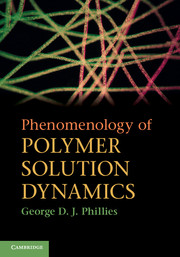Book contents
- Frontmatter
- Contents
- Preface
- 1 Introduction
- 2 Sedimentation
- 3 Electrophoresis
- 4 Quasielastic light scattering and diffusion
- 5 Solvent and small-molecule motion
- 6 Segmental diffusion
- 7 Dielectric relaxation and chain dimensions
- 8 Self- and tracer diffusion
- 9 Probe diffusion
- 10 Dynamics of colloids
- 11 The dynamic structure factor
- 12 Viscosity
- 13 Viscoelasticity
- 14 Nonlinear viscoelastic phenomena
- 15 Qualitative summary
- 16 Phenomenology
- 17 Afterword: hydrodynamic scaling model for polymer dynamics
- Index
- References
11 - The dynamic structure factor
Published online by Cambridge University Press: 05 August 2012
- Frontmatter
- Contents
- Preface
- 1 Introduction
- 2 Sedimentation
- 3 Electrophoresis
- 4 Quasielastic light scattering and diffusion
- 5 Solvent and small-molecule motion
- 6 Segmental diffusion
- 7 Dielectric relaxation and chain dimensions
- 8 Self- and tracer diffusion
- 9 Probe diffusion
- 10 Dynamics of colloids
- 11 The dynamic structure factor
- 12 Viscosity
- 13 Viscoelasticity
- 14 Nonlinear viscoelastic phenomena
- 15 Qualitative summary
- 16 Phenomenology
- 17 Afterword: hydrodynamic scaling model for polymer dynamics
- Index
- References
Summary
Introduction
We now consider measurements of the dynamic structure factor S(q,t) of substantially monodisperse polymers. The work here represents a sixth application of light scattering spectroscopy, as discussed in Chapter 4, to solution dynamics. Prior Chapters 6, 7, 8, and 9 included light scattering determinations of segmental motion, self- and tracer diffusion, rotational diffusion, and probe diffusion. The immediately prior chapter included light scattering spectra of colloidal systems, in which the underlying forces (hydrodynamic, volume exclusion) are much the same as in polymer solutions.
Monodisperse solutions of flexible coils present new complications not seen in earlier discussions of light scattering spectroscopy. Light scattering measurements of rotational and segmental diffusion are only sensitive to a single “internal” variable, an orientation vector or tensor. Self- and tracer diffusion use dilute scattering chains in the presence of a nonscattering matrix, at small scattering vector q; neither chain internal modes nor interference between scattering from pairs of tracer chains affects the scattering spectrum. Scattering from colloids and optical probes examines center-of-mass motion of rigid particles that have no significant internal modes. Here the scattering polymer coils are flexible and often are nondilute, so light scattering spectra include relaxations arising from single-chain center-of-mass displacements, relative motions of chain segments on a single chain, and correlations between positions and motions of chain segments on pairs of chains.
- Type
- Chapter
- Information
- Phenomenology of Polymer Solution Dynamics , pp. 320 - 354Publisher: Cambridge University PressPrint publication year: 2011

